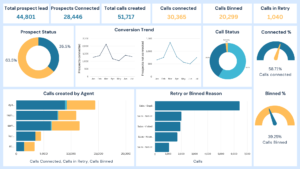In the dynamic landscape of customer service, call centers stand as the front lines where businesses directly engage with their clientele. Amid the constant influx of calls and the critical task of converting prospects into loyal customers, a delicate balance of coordination and efficiency becomes paramount. Traditionally, the call center environment has been synonymous with challenges – high call volumes, fragmented communication channels, and a lack of real-time insights into agent performance and customer interactions. However, in the face of this chaos, Techmax Technologies CX Dashboard emerges as a revolutionary game-changer. With its sophisticated capabilities, this dashboard has the transformative power to reshape the traditional chaos of call centers, evolving them into streamlined and highly coordinated operations.
The Evolution of Chaos in Call Centers
Call centers have historically faced a wide range of difficulties, which has led to operations that were frequently marked by chaos. Significant challenges have always included handling large call volumes, figuring out fragmented communication channels, and lacking real-time insights into agent performance and customer interactions. This confluence of challenges not only hindered overall productivity but also constituted a serious risk to the caliber of customer service provided. The difficulty in maintaining a unified and effective atmosphere amidst these obstacles highlighted the urgent requirement for a revolutionary resolution that could tackle the underlying reasons behind the disorder in conventional call center functions.
Enter Techmax Technologies CX Dashboard
Introducing itself as a comprehensive solution poised to directly address the chaos inherent in traditional call center operations, Techmax Technologies CX Dashboard emerges onto the scene. This innovative dashboard is strategically designed to confront the challenges head-on. With its robust features, it provides call centers with a powerful tool for real-time data analytics. This capability not only revolutionizes the operational landscape but also empowers call centers to fundamentally transform the way they function and coordinate their various activities. The introduction of Techmax Technologies CX Dashboard represents a pivotal moment in the quest for efficiency and order within the realm of call center management.

CX DASHBOARD
Data-Driven Coordination
The ability of the Techmax CX Dashboard to use the power of data is an outstanding feature. This dashboard distinguishes itself by providing real-time statistics on critical key performance indicators (KPIs), such as total prospects lead, calls connected, and conversion trends. This real-time knowledge provides call center managers with actionable data, allowing for a dynamic and data-driven approach. The ability to harness and comprehend this data provides decision-makers with the tools they need to make better informed and successful decisions. As a result, this data-driven strategy becomes the foundation for enabling coordinated responses to customers’ diverse and dynamic needs, indicating a considerable improvement in the call center’s capacity to navigate and address difficulties with precision and agility.
Sales Enquiry Coordination
Techmax CX Dashboard excels at delivering a comprehensive solution for sales inquiries. This dashboard assists call center agents in prioritizing and structuring their interactions with maximum success, thanks to a detailed analysis that provides insights regarding total prospects lead and prospects connected. The extensive evaluation of these important data enables agents to identify and focus their efforts on the most promising leads, allowing for a targeted and efficient approach. This strategic alignment improves overall conversion rates, highlighting the critical significance of Techmax CX Dashboard in optimizing sales enquiry coordination. In essence, this feature provides call center workers with the tools they need to manage the complexities of sales encounters with precision, resulting in a more efficient and successful conversion process.
Service Excellence Redefined
Techmax CX Dashboard emerges as a disruptive force in the field of service inquiries, redefining service excellence. Recognizing the critical role of coordination in this area, the dashboard provides a comprehensive view that includes calls created, calls in retry, and calls binned. This complete understanding provides call center managers with the skills they need to efficiently coordinate troubleshooting efforts. The dashboard, by taking a proactive approach, guarantees that service-related concerns are addressed swiftly and precisely. Techmax CX Dashboard plays a critical role in increasing customer satisfaction by enabling quick and coordinated responses to difficulties identified by data such as calls in retry or binned. In essence, this feature represents an important change in the approach to service excellence, establishing the dashboard as a priceless tool.
Agent Empowerment and Accountability
The dashboard goes beyond its role in facilitating coordination to make a significant contribution to agent empowerment and accountability. Agents obtain a thorough awareness of their impact on the whole business by providing vital insights into individual performance measures. Metrics such as calls created by agents and connected % play an important role in building an accountability culture inside the contact center. Agents are encouraged to strive for excellence in every client engagement, armed with a clear view of their contributions. Individual accountability not only improves agent efficiency but also instills a sense of ownership and pride in their position, ultimately contributing to a higher standard of service delivery.

Looking Ahead: Future Trends in Call Center Coordination
As technology continues to evolve, so does the landscape of call center operations. Techmax Technologies CX Dashboard is not just a solution for the present but a glimpse into the future of call center coordination. The integration of artificial intelligence, machine learning, and predictive analytics holds the promise of even more efficient and intelligent call center management.
In conclusion, Techmax Technologies CX Dashboard emerges as a true game-changer for call center coordination. By addressing the historical chaos associated with call centers, it not only streamlines operations but also elevates the quality of customer service. As businesses navigate the ever-evolving demands of customer interactions, having a tool like Techmax CX Dashboard becomes not just an advantage but a necessity in the pursuit of excellence in customer service coordination.





